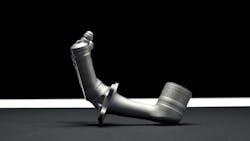Say what you will about Jeff Immelt's mercurial tenure as General Electric chairman and CEO, but no one can ever accuse him of standing on the sidelines of history. He was thrust into the game and played hard. He assumed the mantle from Jack Welch Sep. 7, 2001, the man who increased the company value by an inconceivable 4,000%. Four days later America was attacked by terrorists and everything would change, not least of which was how the world viewed aviation, one of GE's key businesses. He probably wasn't even done unpacking his office and the world was already an absolute mess.
The next 16 years would create several new hardships and opportunities, and Immelt seemed all-in. Under his leadership, GE divested itself of its past, for instance selling off GE Appliance and NBC Universal, and invested in the future with more fuel-efficient jet engines, "brilliant" factories and a new business in GE Additive. Those decisions broke ground for what we now know as the Fourth Industrial Revolution and proved Immelt had the right vision.
On his last day, July 31, 2017, he left several words of wisdom, chief among them explaining his "tough decisions."
"As CEO you must not fear judgment or criticism," Immelt wrote. "Remember, every job or decision looks easy until you are the one on the line."
His successor John Flannery learned that the hard way as GE's stock dropped 56% in 2018. His stint lasted 14 months, a sign that while Immelt's grand vision of the digital factory was keen, with broad strokes such as the Predix Platform for IIoT development and the creation of GE Digital, the whole picture was not as it appeared. Ultimately, it turned out to be more of an Impressionist's painting, getting spottier the closer you inspect it.
Pick any Industry 4.0 stat, it's going to show torrential revenue raining down. For example, Statista forecasts that between 2015 and 2020, the number of worldwide connected IoT devices will have nearly doubled to 30.7 billion. And GE was prepared, basically making umbrellas during monsoon season (and octopus season).
A company with such an early jump in such a disruptive technology cannot suffer such a historic fall and still claim they knew what they were doing.
And to his credit, Immelt doesn't. He admits his failings in a paper for MIT Sloan co-authored by former GE innovation consultant Vijay Govindarajan:
"Just nine years ago, for instance, General Electric didn’t track [digital technologies] closely, never thought about how they could fit in with the machines it manufactured, and, above all, didn’t realize it could make money from them. Digitalization was far removed from GE’s industrial reality."
That is the type of honesty, and wake-up call the world of manufacturing needs right now. And whatever you think of Immelt, now the executive chairman of athenahealth, his perspective is even more keen with the advantage of hindsight. He's also keen on transferring that knowledge. He'll be hosting The Digital Factory Conference 2019 on May 7 in Boston (put on by additive company Formlabs), where he will speak about the current challenges and opportunities for manufacturing leaders.
We interviewed Immelt in late March to find out what he'll be talking about:
IndustryWeek: What's the major reason you're involved with the Digital Factory Conference?
Jeff Immelt: Manufacturing has been a recipient of tools but not a driver. And I wanted to create a forum that was really built around the frontline manufacturing person and the intersection of how they do their work plus the wave of the next-generation technologies that is going to inhabit the space.
The challenge is how do we how do we empower front line production supply chain people to kind of harness the next generation of tools. One of the things that I always worried about particularly leading a legacy company is do people know the art of the possible? Do they know what exists?
The challenge for leaders is to understand you know how to get to your team what's really possible from a standpoint of new investment, new technologies and how they can be used.
And then on the other side, in order to really be good at execution, you have to understand how workers do their work. And you have to understand how the tools fit into the work path and things like that. So I see both of those lacking to a certain extent today.
IW: How do companies reconcile these shortcomings?
Immelt: If you're investing in a manufacturing or production system or an ERP, the CIO makes that decision. And the manufacturing person is the implementer of that system. And I think particularly in manufacturing, there's going to be a wave where the workers are the drivers, not just the receiver of all these technologies. I personally don't think it can be led exclusively by the CIO. It's got to be led by a digitally savvy supply chain person.
IW: How did GE start its digital transformation?
Immelt: It wasn't until probably 2009 to 2010 where we started understanding that the power of having sensors and real time information around industrial equipment could really drive profound changes in productivity, predictive analytics and things like that. When we started it was more on the installed base around jet engines and gas turbines and CT scanners than it was even in our own factories.
If you go the last decade in our case, it started with the installed base first and then it bled its way back to how we ran our factories how we ran administrative sites and things like that.
IW: IT/OT convergence, and leaders and workers sharing a vision, is a big focus in manufacturing right now. Back then, when you made plant visits, were you hearing different things form the C-suite and factory floor?
Immelt: Oh sure. I think it's always a fact of seeing is believing, so the extent to which people could understand the benefits and see them for themselves. They were sucking the tools instead of having them forced on them.
It's a function of return on investment. What I saw is the teams that really were technically savvy, they would request more investment, but they would also sign up for the benefits. They were making their own financial case and it was coming more from the factory floor than it was from the top down. And the teams that weren't as digitally savvy, they were the ones that weren't asking for the investment dollars, nor were they trying to drive new levels of performance. That was clear when you could see the work actually being done.
IW:Based on what we know, one business that this really describes this is GE Aviation and how they drove both Predix and additive manufacturing. What was going through your head when you held that first 3D-printed fuel nozzle that was so much lighter and turned about 20 parts into one?
Immelt: As we were doing the LEAP engine, one of the things about each one of these iterations of engines is to get more fuel efficient. The team probably started showing me six or eight years ago the fuel nozzle, 26 parts to one, extremely hard to make. So I was sold on the efficacy of it and then we had the team do an internal survey of how many parts inside the totality of GE would be advantaged if they could be made using continuous or additive design technologies. We came up with like 600 parts worth $3 billion of savings. That really catches your attention when you see it.
IW: What's the next frontier where additive is going to make that big a stride as a medical and aerospace in your opinion?
Immelt: Niche markets like jewelry. It's going to have a huge impact there. Some of the other consumer industries like shaving and shoes. So you're going to see a whole wave of consumer applications where it has a good fit and good volume.
And then we're just at the very early days of automotive. It's all a function of part size and speed. As we begin to solve for parts size speed quality post-processing things like that, just larger and larger markets are going to open up. We're also moving from the prototype and tooling space to more production units. And so that's where the industry is still in—the early days.
IW: You often mention the four A’s—artificial intelligence, analytics, automation, and additive manufacturing. Which one do you think your peers in manufacturing leadership are deficient in?
Immelt: Additive of the four is the most narrow. If you've used it, you know the power. Everybody's had some experience with analytics or automation. But how do you articulate the advantages of artificial intelligence without escaping into a kind of hyperbolic gibberish? If I want to talk about machine learning, I talk about sending a good invoice to a hospital or getting reimbursement from Medicare or Medicaid using a CPT code.
I try to come down to the micro example and not get lost in the macro. And I think one of things we want to try to do was sessions like Digital Factory is maybe have some generalizations, but getting you people who are in attendance to understand a case so that they can build their own context versus starting with such a macro view that you just get lost in the buzzwords.
IW: What's one topic of Digital Factory that you're excited to see?
Immelt: There's going to be a little bit of a context around future of work and how do you position the workforce to be able to kind of leverage these tools as that goes on. So I think that's going to be quite interesting.
Go watch a worker that is doing high level assembly and go from an instruction manual to the task and then compare that to how they could do it using VR. It's stunning, but you don't get that unless you actually see how people do their jobs. And I always find that that tends to be what's missing in the discussion: How does work actually get done and how does technology really impact the workflow?
And I think that's really critical. And then allowing the supply chain people have more control over their own destiny in terms of investments and returns
To find out more about the Digital Factory Conference, visit www.thedigitalfactory.com/. Use the promo code INDUSTRYWEEKREADER to receive 30% off when you register.








